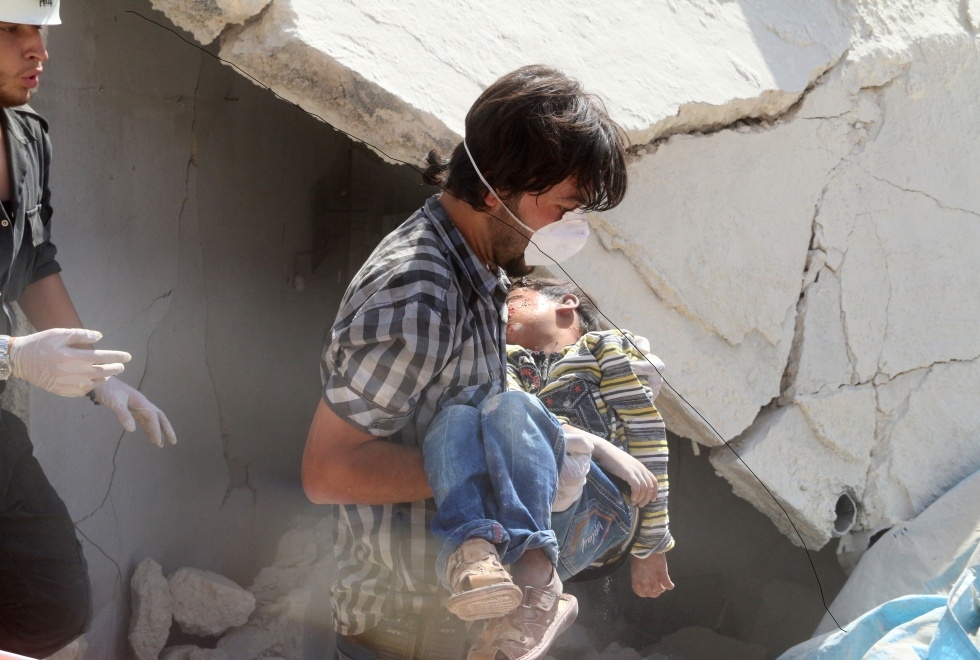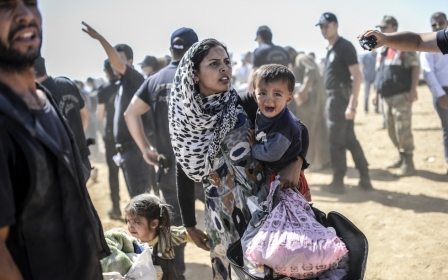Hope: The greatest weapon against the dogs of war in Syria

The fourth anniversary of the Syrian conflict, the most destructive, brutal and destabilizing one yet of the 21st century is upon us, with no end in sight. As the hapless people of this broken nation prepare to enter their fifth year of incessant suffering, many will look back in disbelief at how it all went so very badly wrong, wondering if the future holds more of the same, or a glimmer of hope for something better.
What started as part of the “Arab Spring”, a popular movement for change, basic rights and freedoms after decades of repression and misrule, soon degenerated into a nightmare of unadulterated violence, extremism and destruction as Syrians helplessly looked on in despair, unable to stop their country’s inexorable slide into an abyss of chaos, or to stop themselves from becoming the fuel for its inferno. In its wake, it left millions of shattered lives, devastated communities and a nation teetering on the brink of annihilation.
Aside from the direct and visible impact of war, the hundreds of thousands killed, maimed or missing, the millions displaced internally or in neighbouring countries and the vast destruction of the nation’s infrastructure and priceless heritage, there are also less obvious but equally devastating repercussions. These can mainly be defined in terms of the fracturing and polarisation of Syrian society itself along sectarian, social and geographic lines, as well as the indirect human toll of the conflict.
Brain drain and youth drain
This hidden human cost manifests itself in a blighted “lost generation” of millions of children without proper access to education and healthcare, languishing in poverty and deprived of the basic constituents of a normal childhood. The other aspect is the mass migration of the country’s young men and women as they seek better futures or flee to avoid conscription in the army or joining rebel groups out of economic necessity. Some have sold all their possessions to pay exorbitant amounts to people smugglers and risked their lives making the dangerous journey to Europe, a sure sign they never plan to return.
Syria is haemorrhaging its professionals, the doctors, lawyers, teachers engineers and skilled workers so vital to rebuilding the nation after the fighting stops. A “brain drain” and a “youth drain” that will set back the nation’s development decades and frustrate efforts to repair the extensive damage done by war. This human dimension to the toll of civil war is the most profound and will have the longest lasting and most disruptive legacy.
Reconstruction is not an impossible task. We can rebuild our homes, schools, hospitals, churches and mosques brick by brick if necessary. With time we can even restore our historical heritage and prevent it from being lost forever. But it is far from certain whether the same can be said of the human aspect.
While no one can bring back the victims of war from the dead, it is the ones still living that constitute the greatest challenge. How to repair the deep rifts that now separate and divide communities? How to reconcile people on opposite sides of the divide that have suffered and lost loved ones at the hands of their former friends and neighbours? How to extinguish the flames of mutual hatred, suspicion and desire for vengeance that run very deep? What to do about the areas that have fallen to radicalisation and extremism by the hordes of jihadi fighters and preachers that entered Syria and found fertile ground for their ideology among the desperate, impoverished or marginalised?
The curse of radicalisation
While jihadi fighters can be defeated, the population they have impacted cannot. It will require a gargantuan effort in terms of social and economic development, as well as investment in education and training programmes to reverse the damage done, especially among the impressionable children who were, in many cases, the prime targets for jihadi indoctrination and recruitment. It is doubtful whether a weakened and battered Syria will have the coherent institutions and necessary resources post-war to address this issue effectively on its own. It is likely that without real and substantial aid and support from the international community - which more often than not fails to materialise - the curse of radicalisation will be the most toxic and persistent fallout of the conflict, an intermittent but menacing threat to stability and development far into the future.
The question on everyone’s mind then, is can Syria be put back together again after the conflict ends or is it destined to disintegrate geographically and socially in the aftermath? If previous conflicts around the world have taught us anything, it’s that post-war reconstruction is the easy part; social healing is a different story altogether. Whether these rifts prove to be irreconcilable and unhealable for generations like the Balkans, or if they can be partially or even completely overcome like Northern Ireland, South Africa or Rwanda remains to be seen.
Reasons for hope
But there is hope and cautious optimism that they can, and the reasons are three fold. Firstly, there is no desire among any of the Syrian representatives or supporters of the major warring camps to see Syria split, despite some of their foreign allies finding that an acceptable outcome.
Secondly, although in some parts of Syria sectarian division and animosity run very high and are unlikely to subside for many years to come; in other areas they have withstood the test of a bitter and acrimonious war, albeit becoming frayed in the process. We only need to look at the thousands of Sunni families who fled from Homs, Aleppo and elsewhere to sanctuary in predominantly Alawi coastal cities like Lattakia and Tartus, or the families who fled from rebel-held Ghuta of Damascus to the city. There have been none of the feared reprisals or violence towards them, and they’ve managed to coexist more or less without incident.
The cosmopolitan and diverse large urban population centres of Aleppo City – the regime-held western part – and the capital Damascus have also largely maintained their coherence. Their numerous religious and multi-confessional communities that have cohabited for centuries have refused to be dragged into confrontation with one another. In all those cases, the spirit of Syrian unity has ultimately prevailed and this is an extremely important factor that many observers tend to overlook when projecting future scenarios.
Rejection of sectarianism
This all-important sectarian coherence is extremely vital for the continued survival of the Syrian nation as we know it, and is consequently a constant target of the hard-line Islamist and jihadi groups. Their modus operandi in mixed sect regions of Syria involves incitement by committing war crimes targeting specific groups – namely Shiite and Alawi - in hopes of provoking a major violent backlash against the majority Sunni population. This would help rally more people to their cause, and have the added bonus of cleansing their anticipated future Islamic Emirate from any undesirable “infidels” and “heretics”. All their efforts have so far proved unsuccessful, but not for lack of trying. There is just no appetite by most Syrians to be dragged down that catastrophic path.
Finally and perhaps most importantly is the way displaced Syrians have been eager to return home to rebuild what they can and try to get on with a semblance of normal life in areas that have seen lasting ceasefires like the old quarter of Homs, and some suburbs of Damascus. This shows that there is a real desire to overcome adversity, and that the love of life among Syrians can trump the horrors and scars of war. If we can move beyond the noxious politics of division and incitement, then we have a real chance.
A greater catastrophe
Syrians are a remarkably resilient, resourceful and pragmatic lot, but this is not to underestimate the enormous challenges they will face in reconciling their communities and putting social order back together again after the last guns have been silenced. There is still the very real spectre of a catastrophic degeneration into all out sectarian violence. If this happens, not only will it be the bloodiest chapter of the conflict yet, but will also be the final nail in the coffin of the Syrian nation. Meanwhile, the jihadi radicals and the entrenched warlords will continue to pose a real threat and a serious obstacle to any reconciliation efforts and peaceful settlements and transition.
Holding together the fabric of Syria is not an easy task, and repairing what parts of it have already been torn will become even harder the longer this brutal and chaotic civil war drags on. Syrians are under no illusion as to what lies ahead for their shattered nation, and know it will never return to what it was before the war, regardless of its outcome. They know that contrary to their desires, many powers that back the warring camps wish the conflict to continue indefinitely, at the expense of their blood.
But looking ahead into the future, we do see hope for our nation once again, even if it is in short supply now. The fighting will have to end someday, and that day will be the birth of our renewed hope. Meanwhile, the ever elusive political settlement that promises to do just that is still being chased away and hounded by the war pigs and their dogs of war.
- Edward Dark is MEE's Aleppo-based columnist and writes under a pseudonym.
The views expressed in this article belong to the author and do not necessarily reflect the editorial policy of Middle East Eye.
Photo: A child is rescued from the remains of a shelled building
New MEE newsletter: Jerusalem Dispatch
Sign up to get the latest insights and analysis on Israel-Palestine, alongside Turkey Unpacked and other MEE newsletters
Middle East Eye delivers independent and unrivalled coverage and analysis of the Middle East, North Africa and beyond. To learn more about republishing this content and the associated fees, please fill out this form. More about MEE can be found here.





